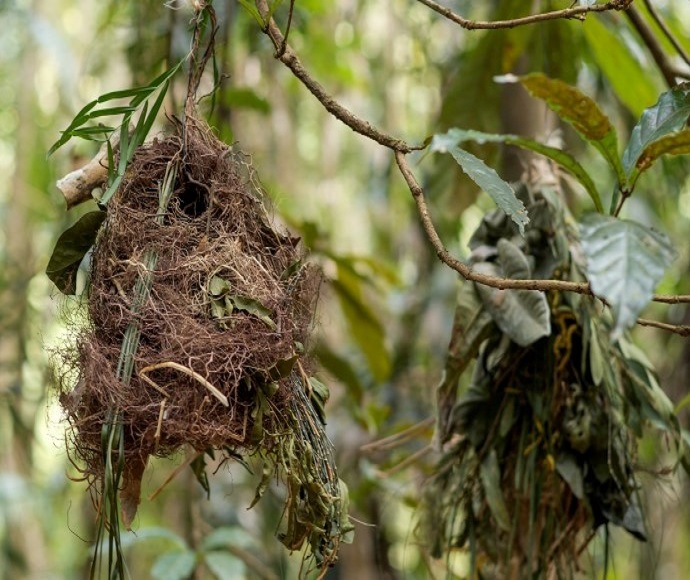Golden tipped bats make Indigenous woven roosts their home on NSW mid north coast
A tiny, six gram threatened bat species has been found living in Indigenous hand woven roosts for the first time, after many of their natural homes were destroyed by bushfires.
The Golden tipped bats, who typically roost in abandoned nests made by small native birds, were left vulnerable to predators when the Black Summer bushfires destroyed many of their homes.
After the fires, the NSW Government’s Saving our Species program worked to ‘rebuild’ the bats’ habitat using First Nations knowledge and support from Gumbaynggirr partners, volunteers and school students. They used traditional weaving skills to make hanging roosts from dried local plant parts.
Two years after the roosts were created, Lamah Coe, an Aboriginal Student Trainee with Saving our Species, found the first pair of bats in their new home during a routine inspection last month.
A second pair of bats was found last week, leading scientists to believe the bat colony is now acclimatised enough to start moving in.
Around 60 roosts were installed in preparation for this moment and in the meantime a range of other native animals have benefited from using the roosts, including scrub wrens, honeyeaters and native rodents.
It’s a huge boost for the project which blended Western science and Indigenous cultural practices to produce the roosts, and shared the learning across the community to support the Golden tipped bat.
Uncle Gary Williams, the project partner at the Muurrbay Aboriginal Language and Culture Co-operative, coined the phrase and project name, ‘Girrimarring wiirrilgal bulany ngayanbading’, which translates to 'bat nest type fur sun like'.
The project is managed by Saving our Species in partnership with the Muurrbay Aboriginal Language and Culture Co-operative and the Yarrawarra Aboriginal Cultural Centre, both on Gumbaynggirr Country, with support from WIRES National Grants program and the Australian Government’s Bushfire Recovery Program.
Quote attributable to NSW Minister for Climate Change and the Environment, Penny Sharpe:
'The discovery of Golden tipped bats in these carefully woven First Nations ‘homes’ is a promising sign that our scientists will be able to help the species recover from the bushfires.
'This project is a perfect example of how the environment can benefit from bringing together First Nations’ knowledge, research from Saving Our Species programs and the community.'
Quote attributable to Minister for the Environment and Water Tanya Plibersek:
'We know many of our threatened species were affected by the horrific Black Summer bushfires. Many are still feeling the effects today – with habitat destroyed, weeds and feral animals taking over, and populations still concerningly low.
'Projects like this give us hope. Drawing on First Nations knowledge to help forests rejuvenate and give these tiny, threatened microbats a safe home shows how we can work together to better protect nature for the future.'
Quote attributable to Lamah Coe, Aboriginal Student Trainee who works one day a week with SoS (and found the microbats):
'I was excited to find those bats inside the woven roosts.
'I shone the torch from underneath the roost and could see the golden tipped fur. It was my first time seeing a wild golden tipped bat.'
Quote attributable to Alison Williams, creative director with the Yarrawarra Aboriginal Cultural Centre:
'We are moved and very excited that we were able to work towards saving the golden tipped bat using cultural knowledge and natural resources.
'This was a wonderful project that brought community, both young and old together, to give back to the environment. Well done to all involved.'
